 Researches & Developments Researches & Developments
2023
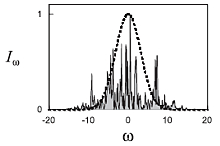 |
A new method for generating noise-like pulses in fiber lasers by synchronizing radiation modes
during periodic compression/expansion of solitons has been developed and investigated.
The compression/expansion of solitons can be carried out in fibers with a dispersion of different signs.
The research results help to understand the mechanisms involved in the generation and stabilization of
noise-like pulses in fiber lasers and open the way to the creation of incoherent lasers based on these
pulses.
|
 |
A new effect has been detected associated with the occurrence of an oscillation of resonant absorption of radiation
in a cell with rubidium vapor in the presence of nitrogen and xenon, the polarization of which was carried out using
spin-exchange optical pumping. The effect is observed in a range of parameters close to the working ones, therefore,
its study has practical significance.
|
2022
 |
By a small modification of a compact CPT clock, an ultra-sensitive (sub-nT/Hz^1/2 level) magnetometer was developed featuring high angular
resolution (~10–2 degrees). The salient features of this unique atomic magnetometer are absence of moving parts and compact dimensions.
In this modification of the initial atomic clock, a 3-axis Helmholtz coil system was used for compensation of the external magnetic field.
The coil system frame may be fabricated by 3D printing.
|
 |
An overview was updated with focus on application of broad-band radiation in optical communication systems.
Recent progress is demonstrated in development of super-continuum (various mechanisms of spectral broadening etc.)
for fibre-optical and open-air optical telecommunications. Multi-channel WDM and DWDM technologies are receiving a new
impetus to adoption of super-continuum as the source of radiation. As one of the still unresolved problems, spectral
non-uniformity of parameters of this radiation is indicated. The efforts of many research groups are aimed at this problem.
Uniformisation of super-continuum parameters in various spectral ranges will allow major adoption of this radiation type
in optical communication
|
2021
 |
A deep analysis is provided of machine learning methods as applied to those lasers that are difficult
to tune manually. Despite the limited knowledge of the properties of some lasers, such lasers may be
implemented as applied technological devices with the help of machine learning methods. In isolated cases,
these methods may be effective in transforming a studied non-linear physical system into a practically
useful device. Application of machine learning methods in fibre lasers is in the mainstream of the
modern technologies that combine simple operation with the possibility of flexible control over
complex systems.
|
 |
Advantages of quasi-synchronous pumping are demonstrated when the pump laser current modulation frequency and the
cavity fundamental frequency of the fibre master oscillator are not exactly matched. Relatively high energy of
nanosecond pulses (130 nJ) was achieved at the repetition rate within the sub-MHz range. The developed laser has
the advantage of absence of both saturable absorber and optical modulator. The proposed method ensures generation
and profiling of nanosecond pulses despite the millisecond-range lifetime of the upper laser level. The demonstrated
approach also raises hopes of further shortening of the generated pulses.
|
2020
 |
We propose and study a method of transformation from structured noise-like laser pulses into conventional
unstructured coherent pulses by way of stimulated Raman scattering. We show that the transformation efficiency
may exceed 45%. The presented efficient approach to conversion of noise-like pulses that are able to carry rather
high radiation energy at relatively high average power makes it possible to consider noise-like pulses as
promising carriers of high radiation energy.
|
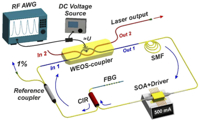 |
A method of electronic switching among significantly different pulsed generation regimes in fibre lasers was developed.
A waveguide electro-optical switch that can vary optical transmittance according to an electrical signal may be used as an
electrically controlled element of the laser cavity. Used as the output coupler, this element allows realisation of a
broad variety of pulsed generation regimes, including also mode locking, harmonic mode locking, and Q-switching.
Extensive functional capabilities of this electronically controlled element are for the first time demonstrated.
The generally limited choice of electrically controllable all-fibre optical elements emphasises the importance of such
studies.
|
2019
 |
Studied are the prospects of reduced energy consumption of a quantum frequency standard on the basis of coherent population trapping effect.
It is established that energy consumption may be reduced by a factor of 1.5 without significant worsening of the clock stability compared
to the standard implementation through optically pumping of 87Rb vapour with multi-frequency laser radiation formed by sidebands of a
single frequency diode laser when its injection current is modulated at a fractional (1/3) frequency of the hyperfine splitting of the ground state.
|
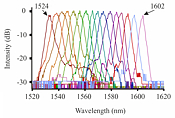 |
Developed and studied is a mode-locked erbium fibre laser featuring uniquely broad tuning of the central wavelength of its femtosecond pulses from 1524 to 1602 nm.
The proposed novel drop-shaped cavity topology of this fibre laser allowed creation of a compact broadly tuneable fs fibre laser of a new generation with
only one discrete volumetric element—a diffraction grating used for spectral tuning of the laser’s output.
|
2018
 |
A new approach has been developed to a single-stage Raman conversion of laser pulses from the 1.1-um spectral range into that of 1.3 um.
The conversion is performed with the aid of femtosecond pulse clusters, synchronous pumping of an external phosphosilicate fibre resonator,
and locking of the pump pulse repetition rate to the inter-mode frequency of the external cavity. This resulted in generation of femtosecond
pulse clusters with record-high energy of 63 nJ at 1270 nm. The cluster envelope had duration of 88–180 ps, while individual sub-pulses were 200-fs long.
|
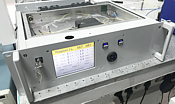 |
For the first time, we demonstrate that broadly different generation regimes can be sustained in an mode-locked ytterbium fibre laser.
Electronic control allowed establishment of stable pulse generation regimes with varying degree of coherence and adjustment of their parameters within
comparatively broad limits: duration, by more than a factor of 2 (30–65 ps for coherent pulses and 77–160 ps for incoherent ones); energy, by more
than a factor of 8 for coherent pulses (1.9–16.2 nJ) and by over an order of magnitude for incoherent ones (2.2–24.8 nJ).
The proposed laser features a relatively high maximal average output power (340–520 mW, depending on the generation regime) achieved without
any additional amplification stages.
|
2015
 |
A laboratory prototype of atomic reference clock has been developed and built on the basis of a coherent population trapping
resonance in 87Rb vapour contained in a miniature spherical optical cell with anti-reflection coating. The reference frequency stability is
demonstrated at 7x10–13 over a 1000-s period. Frequency stability achieved in the developed system approaches the theoretical limit for a
similarly sized cell.
|
 |
A linear compressor of phase-modulated ultra-short pulses has been developed on the basis of optical fibre with anomalous dispersion and
relatively large core diameter (25 um) close to the critical size for single-mode light propagation. The developed device compresses input pulses
down to Fourier limit at peak power of up to 9.4 kW or the average radiation power of 120 mW. At radiation power exceeding these values, compression
is possible down to a certain shortest duration, which is longer than the theoretical Fourier minimum and is determined by a minimal achievable
value of the time-bandwidth product of the input pulses over an optimal length of the fibre-optical compressor.
|
2014
 |
We developed and manufactured an Yb-fibre master oscillator mode-locked by a non-linear amplifying loop mirror and featuring record-high
average output power exceeding 1 W. Generated femtosecond clusters at repetition rate of 25 MHz had envelope duration within 23 ps and
typical duration of internal sub-pulses below 200 fs.
|
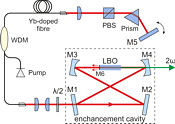 |
A CW fibre laser has been developed and built that features frequency doubling in a high-finesse cavity partially coupled with the laser resonator.
This frequency-doubling configuration of a CW fibre laser in a partially coupled external cavity has been proposed for the first time and
resulted in substantially higher frequency doubling efficiency at relatively low fundamental pump power, at the same time allowing
efficient spectral tuning of the second harmonic radiation line within the 521–545 nm range.
|
2009:
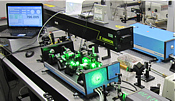
|
The development was completed of a computer-controlled widely
wavelength-tuneable laser aimed at research and technological problems in the
domain of nano-physics and biology. The full working spectral range of this
laser extends from 275 to 1100 nm, while delivering the output line width of
0.5–1 GHz. Automatic tuning of the laser to a specified wavelength is done
with the help of a built-in high-precision wavelength meter and a proprietary
efficient algorithm of control over the selective elements of the laser.
|

|
An all-fibre super-continuum generator has been developed that delivers
record-high output pulse energies reaching 40 uJ. This generator was created
on the basis of a unique ultra-long ytterbium master oscillator with output
pulse energy 4 uJ and a subsequent amplification stage, the output from which
was further guided into a 30-m long micro-structured fibre. With the pulse
duration 10 ns and their repetition rate 37 kHz, high-energy super-continuum
was generated within the spectral range of 500–1750 nm.
|

|
An investigation was carried out of an unusual generation mode
observed for the first time in Yb lasers that features trains of picosecond
pulses with stochastic femtosecond ‘filling’. It was demonstrated that the
observed mode may impede the single-pulse generation in long mode-locked
fibre lasers. The newly obtained generation mode is characterised by a
peculiar double auto-correlation function of the output pulses having a narrow
femtosecond peak on a picosecond pedestal.
|
2008:

|
Mode-locked fiber laser was developed with a few record-breaking
parameters for this type of lasers: record-setting optical length of the
resonant cavity amounting to 3.8 km, ultra-low pulse repetition rate (77 kHz)
and energy per pulse reaching 3.9 uJ without Q-switching, cavity
dumping techniques, or additional optical amplifiers.
|

|
Original fiber-based Q-switched master-oscillator &
power-amplifier system was developed by using Yb fiber with side pumping by
single source. The passive Q-switched system provides for pulse energy up to
110 uJ at CW 12 W single pump. Duration and repetition rate of generated
pulses at 1080 nm can be varied from 280 ns to 1,8 microsecond, and in the
range of 45-140 kHz depending on pump power at 980 nm.
|
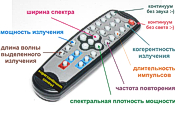
|
Different methods for dynamic control of parameters of
super-continuum generated in fibers both under pulse and CW pumping were
developed and researched. We show experimentally and numerically a sensitivity
of supercontinuum spectral power density to wavelength and repetition rate of
pump pulses. A novel method for control of SC generation under CW pumping is
proposed. We discuss the method for control of repetition rate and duration of
pulses generated with the help of dual-wavelength pumping by means of
adjusting input power and frequency difference. Developed super-continuum
generators with enhanced set of controlled parameters are essential for
cytometry, tomography, spectroscopy, communications and for other applications.
|
2007:

|
For the first time we experimentally demonstrate an efficient
method for the reduction of long-term radiation line drift in single-frequency
cw Ti:Sapphire and Dye lasers that relies on a fast and precise
wavelengthmeter together with a digital–analog feedback system.
The essence of this approach is in the use of high-precision radiation
wavelength meter as a spectral reference. Generation line drift of
lasers was reduced approximately by an order of magnitude down to 40 MHz/hour,
which corresponds to the residual drift in readings of the wavelength meter
itself. The implemented automatic frequency control system allows to locks
the laser generation frequency to a specified absolute value. This approach
may be used in single-frequency lasers of different types (solid-state, fiber,
diode, dye lasers, etc.)
|

|
We research hybrid sub-picosecond systems based on a solid-state
Yb:KYW laser and a side-pumped fibre ytterbium amplifier manufactured using
GTWave technology. When the system was pumped with 12 W of CW radiation at
980 nm 0.9-ps output pulses with energy 40 nJ were generated at the repetition
frequency of 100 MHz and the average radiation power 4 W. The centre wavelength
of the system could be detuned within 1035–1055 nm (pulsed mode) and 1030–1070
nm (CW mode).
|

|
Supercontinuum generation in optical fibers under pulsed and CW excitation is
studied. It was shown that different applications impose different and,
sometimes, opposite requirements on supercontinuum radiation. The optimal
generation regimes are analyzed with regard to various
applications of the effect.
|
|
 Researches & Developments
Researches & Developments























